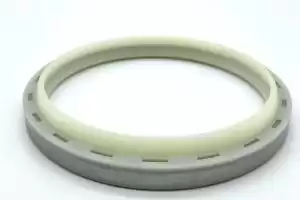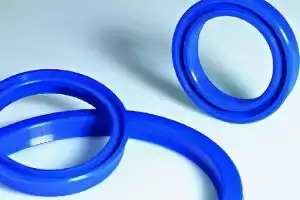There are some significant distinctions between hydraulic and pneumatic seals, two types of sealing devices that are utilized in various systems. The following are the primary distinctions between hydraulic and pneumatic seals:

1,Working Fluid: The working fluid that pneumatic and hydraulic seals encounter is the primary distinction between them. While hydraulic seals are made specifically for use with hydraulic fluids, which are usually oil-based, pneumatic seals are made to work with compressed air or gases.
2,Pressure Range: When compared to pneumatic systems, hydraulic systems typically run at higher pressures. The high pressures that hydraulic seals are intended to withstand usually range from hundreds to thousands of pounds per square inch (psi). Conversely, pneumatic seals are made for lower pressure ranges, usually up to a few hundred psi.
3,Speed: In comparison to pneumatic systems, hydraulic systems frequently operate at higher speeds. High speeds and quick movements are what hydraulic seals are made to handle. Although they are capable of handling moderate speeds, pneumatic seals are typically not made for extremely high-speed applications.
4,Seal Design: Because operating conditions vary, there may be differences in the design of hydraulic and pneumatic seals. Because hydraulic seals are subjected to higher pressures, their designs are typically more robust and may incorporate supplementary reinforcement components like backup rings. Lower pressure pneumatic seals may have more straightforward designs and depend more on the natural flexibility of the sealing materials.
5,Material Selection: Depending on the working fluid and operating circumstances, different materials may be used for hydraulic and pneumatic seals. Rubber, polyurethane, and thermoplastic elastomers are common materials used in hydraulic seals because they are resistant to high pressures and oil-based hydraulic fluids. Similar materials may be used in pneumatic seals, but they may also have different material considerations for gas compatibility and be compatible with either air or gas.
6,Leakage Tolerance: Because fluid leaks can have a negative effect on the effectiveness and performance of hydraulic systems, tighter leakage control measures are usually necessary. The purpose of hydraulic seals is to minimize leakage and offer more effective sealing. Pneumatic systems may be more tolerant of tiny leakage rates, even though they still need effective sealing.
It is crucial to choose the right kind of seal (hydraulic or pneumatic) depending on the particular needs of the system, taking into account factors like speed, pressure range, working fluid, and other operational parameters. Leakage, possible system damage, and poor performance can result from using the incorrect kind of seal.
The following are some instances of systems that frequently employ hydraulic and pneumatic seals:
Pneumatic Seals:
A,Pneumatic Cylinders: Pneumatic cylinders are machines that transform compressed air or gases into linear motion. They frequently use pneumatic seals. Pneumatic cylinders find extensive use across diverse industries, including automation, manufacturing, and transportation.
B,Pneumatic Valves: In pneumatic systems, pneumatic valves regulate the flow of gases or compressed air by using pneumatic seals. Pneumatic control systems, HVAC systems, and industrial machinery are frequently equipped with pneumatic valves.
C,Pneumatic Tools: Air drills, impact wrenches, pneumatic staplers, and air-powered sanders are examples of pneumatic tools that use pneumatic seals. In order to maintain efficiency and stop air leakage, these tools use compressed air to generate power for a variety of applications. Pneumatic seals guarantee appropriate sealing.
D,Pneumatic Actuators: These devices turn compressed air or gases into rotational motion by using pneumatic seals. Control valves, dampers, and other devices that need rotational movement frequently use pneumatic actuators.

Hydraulic Seals
Hydraulic Seals:
A,Hydraulic Cylinders: Hydraulic cylinders, which transform fluid power into linear motion, make extensive use of hydraulic seals. Numerous industries and systems use hydraulic cylinders, such as material handling systems, manufacturing equipment, agricultural machinery, and construction equipment.
B,Hydraulic Pumps and Motors: An integral part of hydraulic systems, hydraulic pumps and motors utilise hydraulic seals. In pumps and motors, these seals guarantee correct sealing and stop fluid leakage, allowing mechanical power to be converted into hydraulic power or vice versa.
C,Hydraulic Valves: Directional control, pressure control, and flow control valves are just a few of the hydraulic valve types that use hydraulic seals. In hydraulic systems, hydraulic valves regulate the direction and flow of hydraulic fluid; maintaining system efficiency requires adequate sealing.
D,Hydraulic Power Units: These units integrate hydraulic pumps, reservoirs, and control valves into one unit. Hydraulic seals are utilized in these units. Automotive lifts, hydraulic presses, and industrial machinery all frequently use hydraulic power units, which supply electricity to hydraulic systems.
These are only a few instances of systems that use hydraulic and pneumatic seals. The particular uses might change depending on the sector and system specifications.







